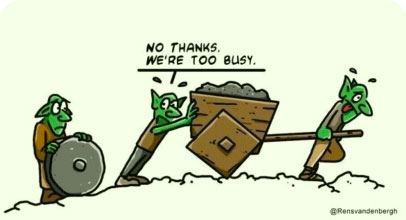
Most of you are familiar with Daily Scrums or Dailies — a short meeting somewhen in the beginning of your day when you meet with the team and share updates, plans and challenges. Then you probably know that it might get tricky to keep your Daily Scrum effective for everyone, especially on remote and this is exactly what we are going to talk about in this article.
Before we proceed with tricks and challenges, let us start with a little bit of theory.
Daily Scrum: the what and why questions
Daily Scrum is an event included in the Scrum framework. Its purpose is to inspect progress toward the Sprint Goal and adapt the Sprint backlog accordingly considering the current progress and the time left.
The Daily Scrum is a 15-minute event for the Developers of the Scrum Team and it focuses on progress toward the Sprint goal. This is the most important metric for the event and it is to be voiced every time you meet for the Daily Scrum. It is to be used to produce an actionable plan for the next work day in order to complete the Sprint goal.
For the next question why Daily Scrum is important, I actually asked my fellow PMs to describe in several words why they believe this event is vital. I have also checked opinions on forums and in articles and come up with this board.

It is quite interesting how many functions and hidden points are covered by Daily Scrum in addition to the main purpose when you conduct a proper event. So you may consider these points as a checklist:) And I will just comment some that I believe could trigger some questions:
- It improves communication. In fact, this is one of very few meetings when the team meets all together and could discuss the current progress;
- It allows you to check priorities. Sometimes it might not be obvious for Developers which task is of greater priority and what is even more important — why; this is actually very true for product teams as ours, for example: we catch up with the team on the current priorities (which might change every day for startups) and share why this or that issue is important right now;
- It reveals hidden process issues. E.g. «what were you doing yesterday» question can reveal process dysfunction. It’s common for team members to reply with, “I didn’t do much yesterday since the majority of my day consisted of meetings”. This could be a sign that your team isn’t operating effectively since employees don’t have time to actually focus on their work — so perhaps some process changes are required.
Daily Scrum challenges
Well, now we know that Daily Scrum is actually important, thanks cap;) But there might still be challenges! This is the list I came up with:
- Keeping the meeting in 15 min timebox
- People not sharing blockers
- Long discussions with just several people involved
- Loss of focus — talking about the process, not the result
- Team members reporting to facilitator, not the team
Keeping the meeting in 15 min timebox
There are many reasons why this could happen, for example too many people in the team (recommended max is 9 members) or sharing too many details.
How to deal?
- If a status update turns into a lengthy discussion then the facilitator should step in and say: «Let’s put this topic in the parking lot and discuss it after the standup is over within a separate meeting»;

Daily Scrum conducted with the Timbo retrospective tool. - Ensure that only 1 person speaks at a time;
- Limit the time for each person to speak to avoid interruptions and irrelevant discussions;
- Instead of asking participants to describe what they did yesterday and will do today, ask instead about what they accomplished and will accomplish;
- Accent a clear start and end and signal the start of standup with a catchy tune, let everyone know it’s over with a simple «And we’re done» or something similar. Clear boundaries help maintain focus.
Misalignment
Ha? Discussing things that are not related to other people’s or perhaps something that only applies to several teammates in a 6-8 persons standup is actually leads to ineffective Dailies, results in other people wasting their time listening to non-relevant information, instead of focusing on meaningful work that’s potentially time sensitive.
How to deal?
- Give team members a phrase or an emoticon to use whenever they worked outside the planned work of the sprint;
- The «rule of 2» works really nice here. Once at least 2 members flag irrelevant issue -> it is to be parked;
- And one more tip — cherish other people’s work and progress. True, we as a team have to focus on work towards the sprint goal. But sometimes team members may be involved in the outside work they want to share, so give them this opportunity (keyword for important offtop things will work great here).
Loss of focus
Talking about the process not the result or talking about anything outside the event's purpose.
How to deal?
- Depersonalize: refocus the answers in terms of jobs to be done instead of being about that person and their day.
Add more focus on actual and projected completion dates so large tasks get more interesting updates. Instead of using the well-known 3 questions, here are 2 alternative questions they suggested asking:- What [tasks] have you finished?
- What [tasks] are you going to finish and by when?
- Make sure you voice the current sprint goal and show examples by attaching your updates to this goal. Simply put, the team should leave with a clear idea of what they’re going to do as a unit RIGHT NOW to get closer to their goal.
People not sharing blockers
Team members may be too embarrassed or uncomfortable to raise the blockers/impediments they need help with. And facilitators often miss this.
How to deal?
- Try to focus on tasks instead of the person to promote more sharing during standups since team members are less afraid of their boss questioning them on a personal level versus focusing on the task itself;
- Don’t forget about the time question, when the task is in progress, make sure to voice the expected deadline and check it is still on;
- Encourage teamwork and shared support to eliminate fear of letting the team down. If something goes wrong, we could fix this together as a team.
Team members reporting to facilitator, not the team
- It may also be useful to have different team members facilitate standup from week to week so there is less tendency for one person to become the leader to whom everyone else feels they must report;
- Also avoid providing a general update of the project progress as a facilitator, let everyone in the team share their own progress.
To sum up everything that has been said...
- Daily Scrum is one of the most important meetings for the Scrum team, it is an opportunity to share success and get into the project;
- As a facilitator always keep Sprint goals in mind, which are the focus to rely on during the event;
- Avoid problem-solving during stand-ups. This is definitely something not for Dailies, better voice things that need decisions -> and cover them afterwards.
- Always check whether your Dailies are healthy and effective. Adopt, try out new things and techniques to keep your team in tones!
Good luck!
Timbo: designed by Scrum Masters for Scrum Masters
 Alexandra Melnikova
Alexandra Melnikova























